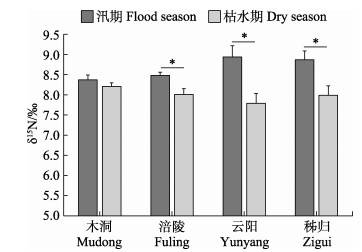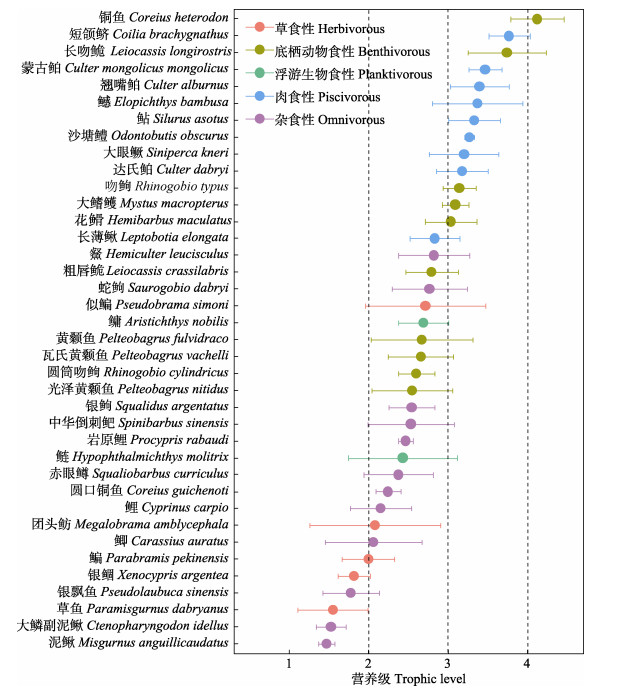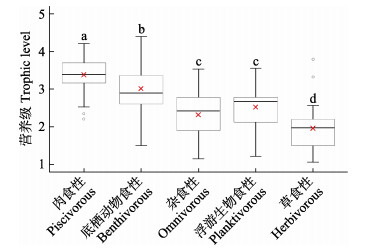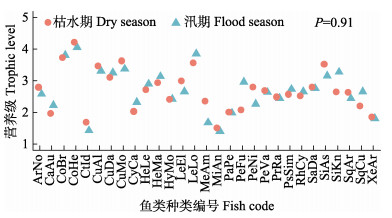2. 中国水产科学 研究院长江水产研究所 农业农村部长江中上游渔业资源环境科学观测实验站 湖北 武汉 430223
2. Fishery Resources and Environmental Science Experimental Station of the Upper-Middle Reaches of Yangtze River, Ministry of Agriculture and Rural Affairs, Yangtze River Fisheries Research Institute, Chinese Academy of Fishery Science, Wuhan, Hubei 430223, China
营养级(trophic level, TL)表征了生物在生态系统或群落食物网中的位置,是复杂食物网络关系中的一个基本的、可测量的特性,反映了食物网的垂直结构(Pimm, 1982; 纪炜炜等, 2010)。营养级的研究有助于划分群落功能群来简化食物网,对生态系统模型的构建及营养动力学研究具有重要意义(Amezcua et al, 2015; 高春霞等, 2020)。目前,对鱼类营养级的分析方法主要包括胃含物分析法(stomach content analysis, SCA)和稳定同位素分析法(stable isotope analysis, SIA),其中稳定同位素分析法基于生物组织中氮稳定同位素的分馏效应,即氮稳定同位素(δ15N)能在食物与捕食者之间产生3‰~4‰的同位素分馏,因此,δ15N常用于确定生物营养级(巴家文等, 2015; 张博伦等, 2019)。和传统的胃含物分析法相比,稳定同位素分析法不仅能更好地反映动物长时间吸收、利用的食物信息(Vander Zanden et al, 1999),还可以连续测出生物的营养位置,能更准确地量化评估生物的营养级(Carscallen, et al, 2012; Amezcua et al, 2015),其为探究营养级及其动态关系提供了一种切实有效的手段并被广泛运用(Power et al, 2013; 张硕等, 2019; 白怀宇等, 2021)。
三峡工程是世界上最大的水利枢纽工程,是治理和开发长江的关键性骨干工程,其在长江流域的防洪、航运、发电以及调节水资源季节分配不均等方面发挥着重要作用(Wu et al, 2004)。但三峡大坝建成后也带来了诸多生态问题,如大坝建设和水库运行使河流水生环境片断化,并改变了河流的物理和化学特征以及河流原有的水文规律(Wu et al, 2003、2004),环境特征的改变可能对鱼类群落结构和鱼类摄食生态产生影响,最终造成鱼类营养结构的差异(Wang et al, 2016; Liu et al, 2019)。由于鱼类营养结构的动态变化能反应鱼类群落结构和鱼类饵料生物的种类组成和丰度的变化状况,而这些变化通常与环境干扰息息相关(薛莹等, 2003; 纪炜炜等, 2010),对三峡库区鱼类营养结构时空差异的研究不仅可以揭示库区鱼类群落的营养格局和结构组成特征,还有助于人们了解水库生态系统演替过程中鱼类食物网营养结构的动态变化及其环境干扰过程。目前,对三峡库区干流鱼类营养级的研究主要集中在水库正常蓄水运行之前(张亮, 2007)和运行初期(Li et al, 2015)。三峡水库蓄水运行多年后,库区鱼类群落结构已经发生改变(魏念等, 2021),这可能对鱼类营养结构产生影响,而有关三峡水库正常蓄水运行后库区干流江段鱼类营养结构时空差异的研究未见报道。因此,本研究运用稳定同位素技术对三峡库区干流包括回水区江段、库首江段、库中江段以及库尾江段4个典型水域不同季节的鱼类营养级进行研究,以期为三峡库区渔业资源评估、保护以及合理利用提供基础科学资料。
1 材料与方法 1.1 调查区域与采样时间三峡水库位于长江中上游,东起重庆市巴南区,西至湖北省宜昌市,全长约600 km,贯穿宜昌市和重庆市的20多个区县,是世界上最大的水利水电型水库。三峡库区属湿润亚热带季风气候,年平均气温为15℃~19℃,年降水量丰沛,季节差异明显。三峡水库采用周期性反季节“冬蓄夏排”的年度水位调节方式,在临近4月的汛期前,三峡大坝水位逐渐下降至145 m的最低水位,汛期后三峡大坝正常蓄水且水位维持在175 m附近(Wu et al, 2004)。
为全面了解三峡库区干流鱼类营养级的时空差异,本研究于2018年7—8月(汛期)和2018年12月— 2019年1月(枯水期)分别在三峡库区干流木洞江段、涪陵江段、云阳江段和秭归江段进行鱼类和基准生物样本采集,其中,木洞江段位于三峡水库干流回水区,涪陵江段位于库尾,云阳江段位于库中,秭归江段位于库首(图 1)。

|
图 1 研究区域及采样点示意图 Fig.1 The study area and sample sites |
鱼类样本的获取主要使用包括流刺网、地笼以及3层刺网在内的渔具进行主动捕捞。鱼类捕捞后现场对采集到的每一尾鱼进行种类鉴定和生物学测量,测量指标包括体长和体重,其中体长测量精确到1 mm,体重测量精确到1 g。用于氮稳定同位素分析的鱼类标本每种鱼选择3~5尾,取其背部白色肌肉2~3 g,用去离子水冲洗后,60℃连续烘干至恒重后干燥保存。基准生物螺类样本主要在地笼中收集,对采集到的螺类进行种类鉴定后,取去除壳和内脏后的肌肉,用去离子水冲洗干净,60℃连续烘干至恒重后干燥保存。
1.3 稳定同位素分析所有样品均使用美国Thermo Fisher Scientific公司的Flash EA1112 HT元素分析仪和DELTA V Advantage同位素比率质谱仪分析氮同位素比率。氮稳定同位素分析的标准物质为标准大气氮(N2)。实验中每5个样品加测1个标准样品,每10个样品中随机选取1~2个样品进行重复测定,分析精度为±0.2‰。
氮稳定同位素比值计算公式如下:
| $ {{\rm{ \mathsf{ δ} }}^{15}}{\rm{N}} = \left({{R_{\rm{s}}} - {R_{{\rm{st}}}}} \right)/{R_{{\rm{st}}}} \times 1000 $ |
式中,Rs表示样品重同位素与轻同位素比值(15N/14N);Rst为标准大气氮同位素比值。
1.4 营养级计算营养级的计算公式如下:
| $ {\rm{TL = (}}{{\rm{ \mathsf{ δ} }}^{{\rm{15}}}}{{\rm{N}}_{{\rm{消费者}}}}{\rm{ - }}{{\rm{ \mathsf{ δ} }}^{{\rm{15}}}}{{\rm{N}}_{{\rm{基准生物}}}}{\rm{)/}}\Delta {{\rm{ \mathsf{ δ} }}^{{\rm{15}}}}{\rm{N + \mathsf{ λ} }} $ |
式中,TL为消费者的营养级,δ15N消费者为消费者氮稳定同位素比值,δ15N基准生物为系统中作为基准生物的氮稳定同位素比值,∆δ15N为相邻营养级之间氮稳定同位素富集度,λ为该基准生物的营养级,初级生产者时λ=1,初级消费者时λ=2。本研究中,相邻营养级之间氮稳定同位素富集度(∆δ15N)取3.4‰ (Post, 2002),同时选择初级消费者螺类作为基准生物。
1.5 数据处理与分析参考FishBase数据库(Froese et al, 2021)和已有文献资料(丁瑞华, 1994; 王赛, 2016),将所采集鱼类分为5个食性类型以研究不同食性类型鱼类组合营养级的差异。5个食性类型包括肉食性鱼类(主要以小型鱼类为摄食对象)、底栖动物食性鱼类(主要以底栖无脊椎动物为摄食对象)、杂食性鱼类(既以动物性饵料为食也以植物性饵料为食)、浮游生物食性鱼类(主要以浮游生物为摄食对象)和草食性鱼类(主要以水生高等植物和固着藻类为摄食对象)。利用单因素方差分析(one-way ANOVA)检验不同江段鱼类的δ15N值和营养级的空间差异,用配对样本t检验分析鱼类的δ15N值和营养级的季节差异,以P < 0.05作为显著水平。分别以不同季节不同江段顶级捕食者(拥有最高营养级的鱼类)的营养级来表征食物链长度(food chain length, FCL)(Sabo et al, 2009)并比较其差异。统计分析和绘图使用SPSS 16.0、Excel 2019和R 4.0.3软件完成。
2 结果与分析 2.1 基准生物氮稳定同位素比值基准生物共采集到螺类3种,包括梨形环棱螺(Bellamya purificata)、铜锈环棱螺(B. aeruginosa)和方格短沟蜷(Semisulcospira cancellate)。氮稳定同位素分析结果显示,不同江段螺类的δ15N平均值为8.37‰,变化范围为8.29‰~8.53‰。单因素方差分析结果显示,不同江段之间螺类的δ15N值无显著差异(P > 0.05);木洞江段汛期和枯水期的螺类的δ15N值无显著差异(P > 0.05),而涪陵、云阳及秭归江段螺类的δ15N值在汛期显著高于枯水期(P < 0.05)(图 2)。

|
图 2 三峡水库干流螺类的δ15N值(平均值±标准差) Fig.2 The δ15N value of snails in the main stream of the Three Gorges Reservoir (Mean±SD) *表示存在显著差异(P < 0.05)。 * indicates significant differences (P < 0.05). |
本研究测定了三峡库区干流不同江段不同季节共计38种鱼的氮稳定同位素比值,结果显示,所有鱼类样本的δ15N平均值为11.02‰,变化范围为5.31‰~17.79‰。其中,木洞江段不同种鱼类的δ15N值范围为5.8‰~15.05‰,涪陵江段为7.04‰~ 14.64‰,云阳江段为6.63‰~16.55‰,秭归江段为5.31‰~14.61‰ (表 1)。单因素方差分析结果显示,不同江段之间鱼类的δ15N值无显著差异(P > 0.05)。配对样本t检验分析结果显示,汛期和枯水期鱼类的δ15N值无显著的季节差异(P > 0.05)。
|
|
表 1 三峡库区干流鱼类体长、体重特征及其δ15N值 Tab.1 Characteristics of body length, body weight and δ15N value of fish in the main stream of the Three Gorges Reservoir |
根据营养级计算公式计算了三峡库区干流江段主要鱼类的营养级并构建连续营养谱,分析结果显示,三峡库区干流鱼类营养级范围为1.47~4.12,平均值为2.67,营养层次为4级,营养级大于4级的鱼类仅有铜鱼(Coreius heterodon) 1种,营养级位于3~4级之间的鱼类占种类总数的31.6%,主要为肉食性鱼类和底栖动物食性鱼类;营养级位于2~3级之间的鱼类占50.0%,主要为杂食性鱼类、底栖动物食性鱼类和浮游生物食性鱼类;营养级位于1~2级之间的鱼类占15.8%,包括3种草食性鱼类和3种杂食性鱼类(图 3)。不同食性鱼类组合营养级呈肉食性鱼类 > 底栖动物食性鱼类 > 浮游生物食性鱼类和杂食性鱼类 > 草食性鱼类(图 4)。

|
图 3 三峡库区干流鱼类连续营养谱(平均值±标准差) Fig.3 Continuous nutrition spectra of fish in the mainstream of the Three Gorges Reservoir (Mean±SD) |

|
图 4 三峡水库干流不同食性鱼类组合营养级箱型图 Fig.4 Box plots for the trophic level of fish assemblages with different feeding habits in the mains tream of the Three Gorges Reservoir 相同字母代表组间无显著差异(P > 0.05)。 The same letter indicate that there is no significant difference between the groups (P > 0.05). |
三峡库区干流木洞江段鱼类平均营养级为2.73,不同种鱼类之间营养级跨度为2.7;涪陵江段鱼类平均营养级为2.79,营养级跨度为2.23;云阳江段鱼类平均营养级为2.68,营养级跨度为3.04;秭归江段鱼类平均营养级为2.44,营养级跨度为2.74。单因素方差分析结果显示,不同江段之间鱼类营养级无显著差异(P > 0.05)(图 5)。除肉食性鱼类组合营养级无显著的空间差异外(P > 0.05),其他同种食性鱼类组合营养级均存在一定的空间差异(表 2)。

|
图 5 不同江段鱼类营养级箱型图 Fig.5 Box plots for the trophic level of fish in different river sections |
|
|
表 2 三峡库区干流不同食性鱼类组合营养级差异(平均值±标准差) Tab.2 Differences in trophic level of fish assemblages with different feeding habits in the main stream of the Three Gorges Reservoir area (Mean±SD) |
三峡库区干流汛期鱼类平均营养级为2.66,变化范围为1.29~4.05;枯水期鱼类平均营养级为2.68,变化范围为1.50~4.22。木洞和涪陵江段鱼类食物链长度的季节变异幅度相对较小,而云阳和秭归江段鱼类食物链长度的季节变异幅度相对较大(表 3)。配对样本t检验分析结果显示,汛期和枯水期的鱼类营养级差异不显著(P > 0.05)(图 6)。
|
|
表 3 三峡库区干流鱼类营养级的时空差异 Tab.3 Spatio-temporal variation of trophic level of fishes in the main stream of the Three Gorges Reservoir area |

|
图 6 鱼类营养级的季节差异 Fig.6 Seasonal differences of trophic level of fish 鱼类种类编号见表 1,P值为配对样本t检验分析结果,下同。 the fish codes are shown in Tab.1, P-value is the result of paired sample t-test analysis, the same as below. |
运用稳定同位素技术开展鱼类营养级的研究中,通常选择初级生产者或初级消费者等食物网中低营养级生物作为基准生物(Vander Zanden et al, 1999)。由于浮游动植物等受其生长环境中理化因素的影响较大,其δ15N值时空差异较大,使用其作为基准生物评估营养级可能会出现较大误差,而周转率低、寿命长、活动范围小的螺类能够整合一定时间和空间尺度上生产者的同位素特征,因此使用螺类作为基准生物更具优势(Post et al, 2002; Wang et al, 2013)。本研究测得螺类δ15N平均值为8.37‰,高于部分鱼类的δ15N值,说明以螺类作为基准生物评估鱼类营养级仍然有一定局限,而其他系统的研究中也存在类似的情况(Abrantes et al, 2014; 蒋日进等, 2014; 邓华堂等, 2015; Li et al, 2015)。对于食物网结构较为复杂的系统来说,其可能包含了诸多不同营养路径的食物链,这使得基准生物的选择更加困难,因此,不同的研究应根据自身所关注的生态学问题与系统特点选择最为合适的同位素基准(徐军等, 2010; Post et al, 2002)。由于所选基准生物的不同会对营养级的计算结果产生影响(Xu et al, 2011; 史方等, 2016; 田甲申等, 2018),为了便于和水库蓄水运行初期的研究进行对比,本研究同样选择在三峡库区数量多,分布广,样本易于获取的螺类作为基准生物,以此保证研究结果的可靠性。除木洞江段外,涪陵、云阳及秭归江段螺类δ15N值汛期显著高于枯水期(P < 0.05),Wang等(2013)的研究发现,在营养浓度较高的水体中,螺类的δ15N值也相对较高,而造成螺类的δ15N值存在差异的原因可能与环境因素有关。由于大部分江段螺类的δ15N值存在显著的季节差异,因此在计算不同季节鱼类营养级时,本研究基准值选用的是各自季节所采集螺类的δ15N值(邓华堂等, 2015; Woodland et al, 2012)。
三峡库区干流鱼类营养级范围为1.47 (泥鳅Misgurnus anguillicaudatus)~4.12 (铜鱼),营养层次为4级,而水库蓄水运行初期鱼类营养级范围为1.29 (草鱼Ctenopharyngodon idellus)~3.55 (鳜Siniperca chuatsi),营养层次为3级(Li et al, 2015)。和水库蓄水运行初期的研究结果相比,本研究鱼类食物链长度更长,营养层次更丰富,造成研究结果差异的原因主要与顶级捕食者的种类组成和其营养级差异有关。本研究营养级最高的鱼类为铜鱼,其营养级大于4级,且在木洞、涪陵和云阳江段均为顶级捕食者,营养级远高于水库运行初期的研究结果(营养级为2.63)(Li et al, 2015),陈薛伟杰(2018)近年在库区干流万州江段的研究也表明,铜鱼具有较高的营养级,由于摄食偏好是决定鱼类营养级的重要原因(闫光松等, 2016),因此,推测造成铜鱼营养级显著升高可能和铜鱼摄食了更高营养级的饵料生物有关。库区干流鱼类营养级大于3级的鱼类种类占31.6%,高于水库运行初期的研究结果(23.4%)(Li et al, 2015),研究结果的差异一方面和鱼类营养级的升高有关,另一方面反应了库区高营养级鱼类的群落结构和营养特征发生了改变。三峡库区蓄水运行多年以后,复杂而稳定的食物网结构逐渐形成,使得库区食物网抵御干扰的能力增强,加之库区可利用资源充足,这为高营养级鱼类的生存和扩张提供了适宜的条件(He et al, 2020)。例如,本研究在调查过程中发现,原来主要分布于长江中下游的短颌鲚(Coilia brachygnathus)在库区中下游江段为主要的渔获物捕捞对象之一,并且其种群动态有从库区下游向上游逐渐扩张的趋势,而在2013—2015年库区干流的渔获物调查中(董纯等, 2019)并未发现短颌鲚,说明短颌鲚是近年开始迅速扩张并逐渐成为优势种的鱼类(魏念等, 2021)。由于外来物种在争夺食物饵料和生存空间方面相对本地鱼类通常处于优势地位(Kolar et al, 2002; 巴家文等, 2012),因此短颌鲚的扩张可能压缩了原有鱼类的生存空间,而短颌鲚是仅次于铜鱼的顶级捕食者,其种群动态可能会对库区食物网营养结构产生影响,后续需加强关注。本研究与Li等(2015)在三峡水库正常蓄水运行初期的研究中均有采集的鱼类有26种。通过比较发现,本研究所测26种鱼类的平均营养级显著高于水库蓄水运行初期的研究结果(P < 0.05)(图 7)。由于所选基准生物种类相同且其δ15N值相似,而鱼类摄食偏好是决定鱼类营养级的重要原因(闫光松等, 2016),因此,推测三峡库区鱼类营养级的升高可能主要与鱼类摄食生态的改变有关,由于水生生物的杂食性和营养塑性普遍存在(巴家文等, 2015),水库蓄水运行多年后,库区各种消费者逐渐适应了库区多变的生态环境,加之库区可利用资源丰富(汤显强, 2020),使得库区鱼类更容易捕食优质的饵料生物而降低杂食性,最终使其营养级升高。

|
图 7 不同年度鱼类营养级的差异 Fig.7 Differences in trophic levels of fish in different years 2011—2012年的数据来自历史资料(Li et al, 2015),2018—2019年的数据为本研究实测所得。 Data from 2011 to 2012 are from historical data (Li et al, 2015), and data from 2018 to 2019 are the measured data of this study. |
三峡库区干流不同江段鱼类种类组成、鱼类营养级范围、食物链长度以及同种食性鱼类的营养级均存在一定的空间差异,但整体上不同江段之间鱼类营养级无显著差异(P > 0.05),说明库区干流不同江段自身环境特征差异和受大坝影响的程度不同主要造成不同江段鱼类食物网的内部结构存在差异,而并未使鱼类群落的营养级在河流纵向梯度上存在显著差异。过去的研究表明,环境变动可能使鱼类所摄食饵料生物的种类组成和比例发生改变,最终造成营养级的波动(巴家文等, 2015; 高春霞等, 2020)。库区干流不同季节的鱼类营养级发生了一定程度的改变,但整体上鱼类营养级无显著的季节差异(P > 0.05),说明季节变化和水库调度可能改变了同种鱼类的摄食组成并对其营养级产生影响,但总体上对鱼类群落营养特征的影响有限,而这可能主要得益于库区干流复杂而稳定的食物网结构和生境异质性缓冲了环境扰动对鱼类营养结构的影响(He et al, 2020)。尽管如此,水库干流越靠近大坝的江段鱼类食物链长度的季节波动幅度越大,这在一定程度上说明了越靠近大坝的江段鱼类营养结构受环境干扰的影响越严重。
ABRANTES K G, BARNETT A, BOUILLON S. Stable isotope-based community metrics as a tool to identify patterns in food web structure in east African estuaries. Functional Ecology, 2014, 28(1): 270-282 DOI:10.1111/1365-2435.12155 |
AMEZCUA F, MURO-TORRES V, SOTO-JIMÉNEZ M F. Stable isotope analysis versus TROPH: A comparison of methods for estimating fish trophic positions in a subtropical estuarine system. Aquatic Ecology, 2015, 49(2): 235-250 DOI:10.1007/s10452-015-9517-4 |
BA J W, CHEN D Q. Invasive fishes in Three Gorges Reservoir area and preliminary study on effects of fish invasion owing to impoundment. Journal of Lake Sciences, 2012, 24(2): 185-189 [巴家文, 陈大庆. 三峡库区的入侵鱼类及库区蓄水对外来鱼类入侵的影响初探. 湖泊科学, 2012, 24(2): 185-189] |
BA J W, DENG H T, DUAN X B, et al. Trophic level analysis on main fish species in the middle reaches of Yangtze River by δ13C and δ15N analysis. Chinese Journal of Zoology, 2015, 50(4): 537-546 [巴家文, 邓华堂, 段辛斌, 等. 应用稳定性同位素(δ13C、δ15N)技术研究长江中游干流主要鱼类的营养级. 动物学杂志, 2015, 50(4): 537-546] |
BAI H Y, WANG Y K, ZHANG T T, et al. Trophic levels and feeding characters of marine fishes in the Yellow Sea and northern East China Sea based on stable isotope analysis. Progress in Fishery Sciences, 2021, 42(2): 10-17 [白怀宇, 王玉堃, 张廷廷, 等. 基于碳、氮稳定同位素研究黄海及东海北部主要鱼类的营养级和食性. 渔业科学进展, 2021, 42(2): 10-17] |
CARSCALLEN W M A, VANDENBERG K, LAWSON J M, et al. Estimating trophic position in marine and estuarine food webs. Ecosphere, 2012, 3(3): 1-20 |
CHEN X W J. Studies on fish food web structure and function of Wanzhou section and Xiaojiang River in the Three Gorges Reservoir. Masterxs Thesis of Guizhou University, 2018 [陈薛伟杰. 三峡库区万州江段和小江鱼类食物网结构与功能研究. 贵州大学硕士研究生学位论文, 2018]
|
DENG H T, BA J W, DUAN X B, et al. The analysis of the trophic levels of the major fish species in the Daning River using stable isotope technology. Acta Hydrobiologica Sinica, 2015, 39(5): 893-901 [邓华堂, 巴家文, 段辛斌, 等. 运用稳定同位素技术分析大宁河主要鱼类营养层级. 水生生物学报, 2015, 39(5): 893-901] |
DING R H. The fishes of Sichuan. Chengdu: Sichuan Science and Technology Press, 1994 [丁瑞华. 四川鱼类志. 成都: 四川科学技术出版社, 1994]
|
DONG C, YANG Z, GONG Y, et al. Fish resource status and biodiversity conservation in the main channel of Three Gorges Reservoir. Journal of Hydroecology, 2019, 40(1): 15-21 [董纯, 杨志, 龚云, 等. 三峡库区干流鱼类资源现状与物种多样性保护. 水生态学杂志, 2019, 40(1): 15-21] |
FROESE R, PAULY D. FishBase[EB/OL]. (2019-8)[2021-5-20]. https://www.fishbase.de/search.php
|
GAO C X, DAI X J, TIAN S Q, et al. Trophic structure of major fishery organisms in the offshore waters of southern Zhejiang: Insights from stable isotope analysis. Journal of Fishery Sciences of China, 2020, 27(4): 438-453 [高春霞, 戴小杰, 田思泉, 等. 基于稳定同位素技术的浙江南部近海主要渔业生物营养级. 中国水产科学, 2020, 27(4): 438-453] |
HE C, DENG H T, BA J W, et al. Food chain length associated with environmental factors affected by large dam along the Yangtze River. Water, 2020, 12(11): 3157 DOI:10.3390/w12113157 |
JI W W, LI S F, CHEN X Z. Application of fish trophic level in marine ecosystem. Journal of Fishery Sciences of China, 2010, 17(4): 878-887 [纪炜炜, 李圣法, 陈雪忠. 鱼类营养级在海洋生态系统研究中的应用. 中国水产科学, 2010, 17(4): 878-887] |
JIANG R J, ZHANG S Y, WANG K, et al. Stable isotope analysis of the offshore food web of Gouqi Island. Chinese Journal of Ecology, 2014, 33(4): 930-938 [蒋日进, 章守宇, 王凯, 等. 枸杞岛近岸海域食物网的稳定同位素分析. 生态学杂志, 2014, 33(4): 930-938] |
KOLAR C S, LODGE D M. Ecological predictions and risk assessment for alien fishes in North America. Science, 2002, 298(5596): 1233-1236 DOI:10.1126/science.1075753 |
LI J, ZHOU Q, YUAN G L, et al. Mercury bioaccumulation in the food web of Three Gorges Reservoir (China): Tempo-spatial patterns and effect of reservoir management. Science of the Total Environment, 2015, 527/528: 203-210 DOI:10.1016/j.scitotenv.2015.04.115 |
LIU X J, QIN J J, XU Y, et al. Biodiversity decline of fish assemblages after the impoundment of the Three Gorges Dam in the Yangtze River Basin, China. Reviews in Fish Biology and Fisheries, 2019, 29(1): 177-195 DOI:10.1007/s11160-019-09548-0 |
PIMM S L. Food webs. London, UK: Chapman and Hall, 1982
|
POST D M. Using stable isotopes to estimate trophic position: Models, methods, and assumptions. Ecology, 2002, 83(3): 703-718 DOI:10.1890/0012-9658(2002)083[0703:USITET]2.0.CO;2 |
POWER M E, HOLOMUZKI J R, LOWE R L. Food webs in Mediterranean rivers. Hydrobiologia, 2013, 719(1): 119-136 DOI:10.1007/s10750-013-1510-0 |
SABO J L, FINLAY J C, POST D M. Food chains in freshwaters. Annals of the New York Academy of Sciences, 2009, 1162: 187-220 |
SHI F, CHEN X J, YANG Z, et al. Determination of fish trophic level in Xiaojiang River of Three Gorges Reservoir by stable carbon and nitrogen isotope Analysis. Journal of Hydroecology, 2016, 37(4): 70-77 [史方, 陈小娟, 杨志, 等. 三峡水库小江流域鱼类营养层次研究. 水生态学杂志, 2016, 37(4): 70-77] |
TANG X Q. Evolution, driving mechanism and control strategy for eutrophication in Changjiang River Basin. Yangtze River, 2020, 51(1): 80-87 [汤显强. 长江流域水体富营养化演化驱动机制及防控对策. 人民长江, 2020, 51(1): 80-87] |
TIAN J S, LI D H, WANG B, et al. Assessment of the trophic level of main fishery species in coastal waters of Daling River and Yalu River based on stable isotope technique. Chinese Journal of Ecology, 2018, 37(4): 1181-1186 [田甲申, 李多慧, 王摆, 等. 运用稳定同位素技术研究大凌河、鸭绿江近岸海域春季主要生物种类的营养级. 生态学杂志, 2018, 37(4): 1181-1186] |
VANDER ZANDEN M J, RASMUSSEN J B. Primary consumer δ13C and δ15N and the trophic position of aquatic consumers. Ecology, 1999, 80(4): 1395-1404 DOI:10.1890/0012-9658(1999)080[1395:PCCANA]2.0.CO;2 |
WANG J Z, LI L, XU J, et al. Initial response of fish trophic niche to hydrological alteration in the upstream of Three Gorges Dam. Ecological Processes, 2016, 5: 11 DOI:10.1186/s13717-016-0055-3 |
WANG S. Structure of fish food webs and energy flow of ecosystems in the East River. Doctoral Dissertation of Jinan University, 2016 [王赛. 东江鱼类食物网结构与生态系统能流模式研究. 暨南大学博士研究生学位论文, 2016]
|
WANG Y Y, YU X B, ZHANG L, et al. Seasonal variability in baseline δ15N and usage as a nutrient indicator in Lake Poyang, China. Journal of Freshwater Ecology, 2013, 28(3): 365-373 DOI:10.1080/02705060.2013.763296 |
WEI N, ZHANG Y, WU F, et al. Current status and changes in fish assemblages in the Three Gorges Reservoir. Resources and Environment in The Yangtze Basin, 2021, 30(8): 1858-1869 [魏念, 张燕, 吴凡, 等. 三峡库区鱼类群落结构现状及变化. 长江流域资源与环境, 2021, 30(8): 1858-1869] |
WOODLAND R J, MAGNAN P, GLÉMET H, et al. Variability and directionality of temporal changes in δ13C and δ15N of aquatic invertebrate primary consumers. Oecologia, 2012, 169: 199-209 DOI:10.1007/s00442-011-2178-7 |
WU J G, HUANG J H, HAN X G, et al. The Three Gorges Dam: An ecological perspective. Frontiers in Ecology and the Environment, 2004, 2(5): 241-248 DOI:10.1890/1540-9295(2004)002[0241:TTGDAE]2.0.CO;2 |
WU J G, HUANG J H, HAN X G, et al. Three-Gorges Dam - Experiment in habitat fragmentation?. Science, 2003, 300(5623): 1239-1240 DOI:10.1126/science.1083312 |
XU J, ZHANG M, XIE P, et al. Variability of stable nitrogen isotopic baselines and its consequence for trophic modeling. Journal of Lake Sciences, 2010, 22(1): 8-20 [徐军, 张敏, 谢平. 氮稳定同位素基准的可变性及对营养级评价的影响. 湖泊科学, 2010, 22(1): 8-20] |
XU J, ZHANG M, XIE P. Sympatric variability of isotopic baselines influences modeling of fish trophic patterns. Limnology, 2011, 12(2): 107-115 DOI:10.1007/s10201-010-0327-z |
XUE Y, JIN X S. Review of the study on feeding habits of fishes and food webs. Marine Fisheries Research, 2003, 24(2): 76-87 [薛莹, 金显仕. 鱼类食性和食物网研究评述. 海洋水产研究, 2003, 24(2): 76-87] |
YAN G S, ZHANG T, ZHAO F, et al. A study on trophic level of the major fishery species from the Yangtze Estuary based on stable isotope technology. Chinese Journal of Ecology, 2016, 35(11): 3131-3136 [闫光松, 张涛, 赵峰, 等. 基于稳定同位素技术对长江口主要渔业生物营养级的研究. 生态学杂志, 2016, 35(11): 3131-3136] |
ZHANG B L, GUO B, YU Y, et al. Study of the food-web structure in the Dashentang artificial reef area in Tianjin using a stable isotope technique. Progress in Fishery Sciences, 2019, 40(6): 25-35 [张博伦, 郭彪, 于莹, 等. 基于稳定同位素技术的天津大神堂海域人工鱼礁区食物网结构研究. 渔业科学进展, 2019, 40(6): 25-35] |
ZHANG L. A stable carbon and nitrogen isotopes study of fishes from the Three Gorges riverine of the Yangtze River. Doctoral Dissertation of Institute of Hydrobiology, Chinese Academy of Sciences, 2007 [张亮. 长江三峡江段鱼类碳、氮稳定性同位素研究. 中国科学院水生生物研究所博士研究生学位论文, 2007]
|
ZHANG S, GAO S K, YU W W, et al. Research progress of stable carbon and nitrogen isotopes in the construction of marine food web and ecosystem community structure. Journal of Aquaculture, 2019, 40(7): 6-10 [张硕, 高世科, 于雯雯, 等. 碳、氮稳定同位素在构建海洋食物网及生态系统群落结构中的研究进展. 水产养殖, 2019, 40(7): 6-10] |





 Saurogobio dabryi
Saurogobio dabryi
 科Serranidae
科Serranidae